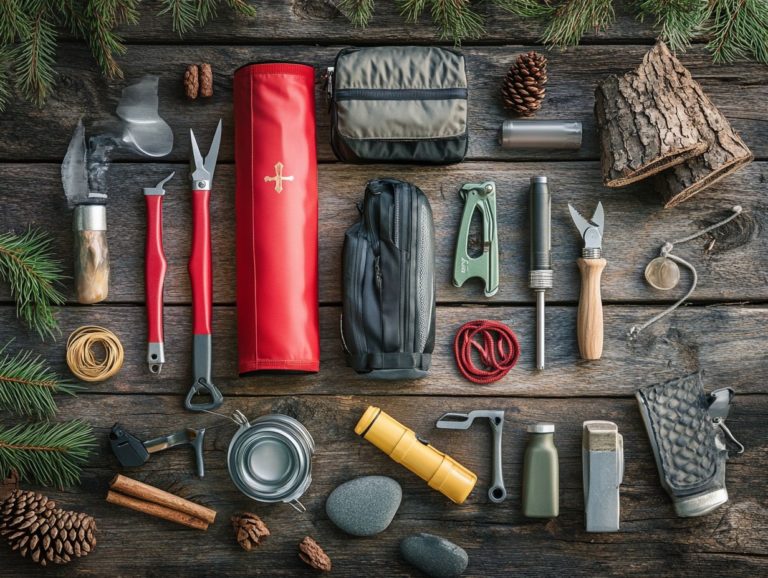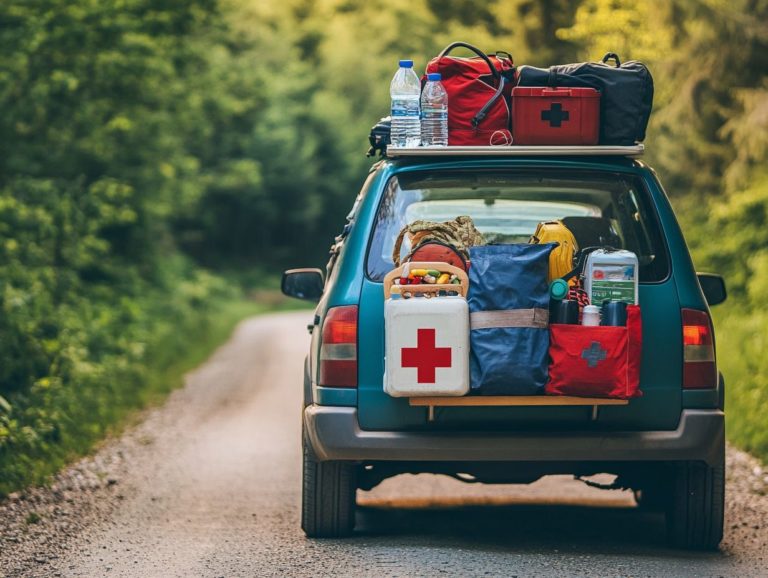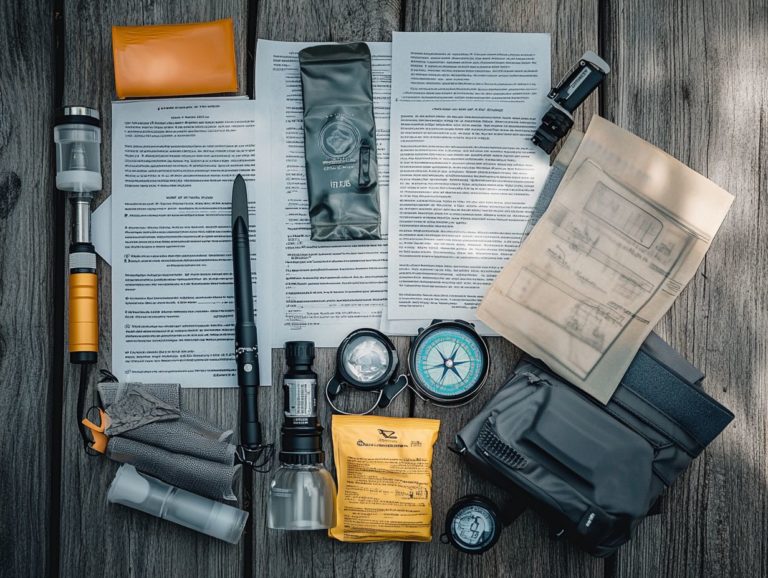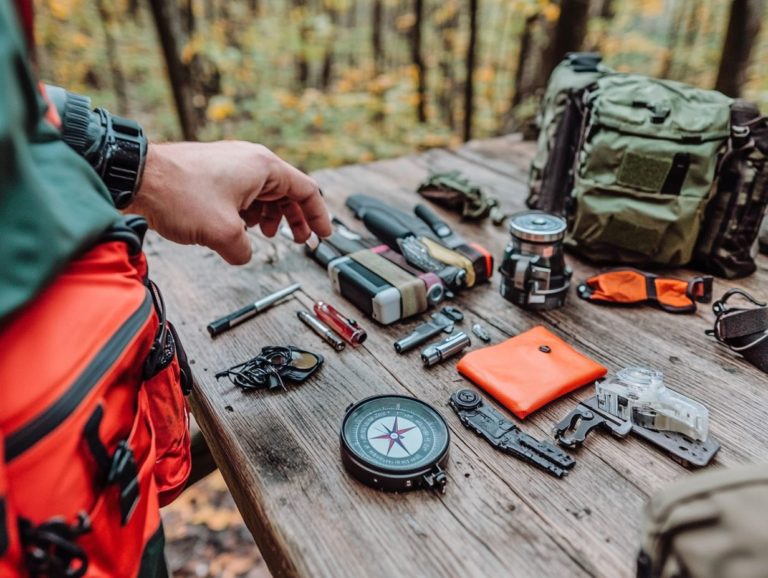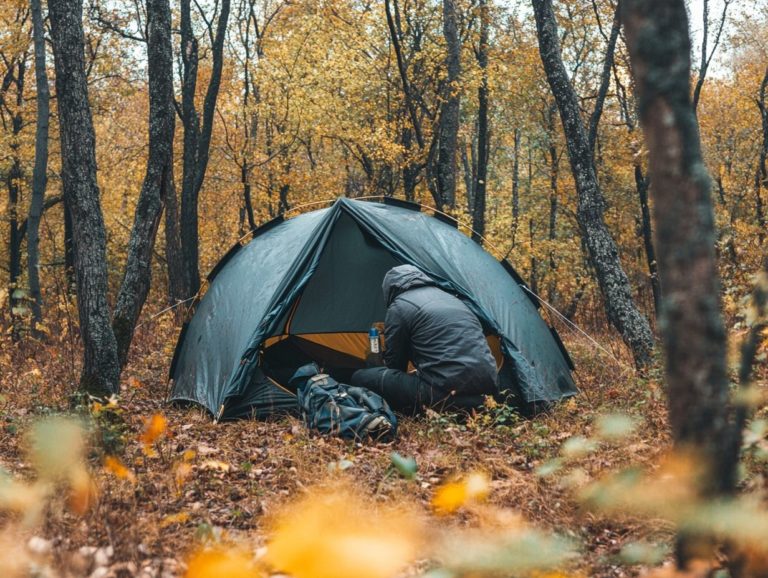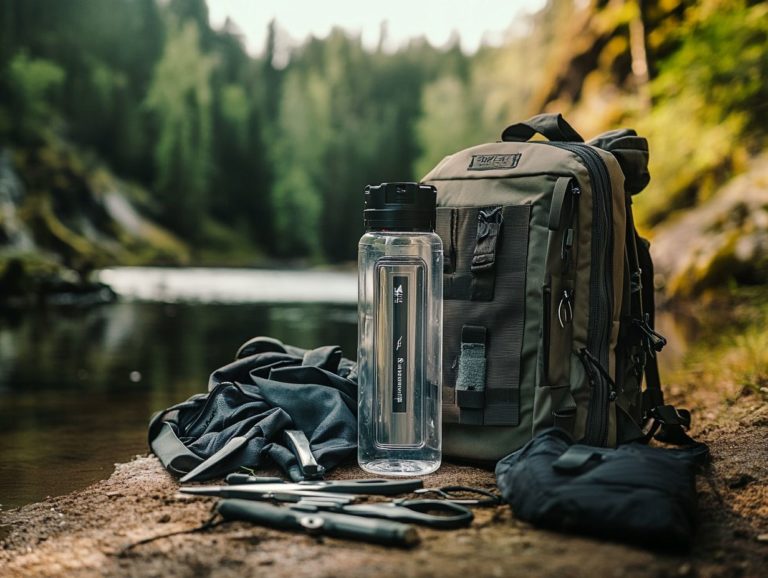How to Choose Survival Gear for Different Climates
Choosing the right survival gear is essential for keeping you warm and safe! Each climate brings its own set of challenges, whether you’re dealing with icy temperatures or sweltering heat. It s crucial to select gear that is specifically tailored to your environment.
This guide will help you navigate the essential equipment needed for cold, hot, wet, and dry climates while also considering your personal needs and budget.
Arm yourself with the knowledge to thrive in any situation uncover the essentials for your next adventure!
Contents
- Key Takeaways:
- Understanding Climate-Specific Survival Gear
- Essential Gear for Cold Climates
- Essential Gear for Hot Climates
- Essential Gear for Wet Climates
- Essential Gear for Dry Climates
- Factors to Consider When Choosing Gear
- Frequently Asked Questions
- What factors should I consider when choosing survival gear for different climates?
- How do I determine the temperature rating for survival gear?
- What type of shelter should I pack for different climates?
- How can I ensure my survival gear is waterproof?
- What are some essential items to pack for survival in a desert climate?
- Can I use the same survival gear for different climates?
Key Takeaways:
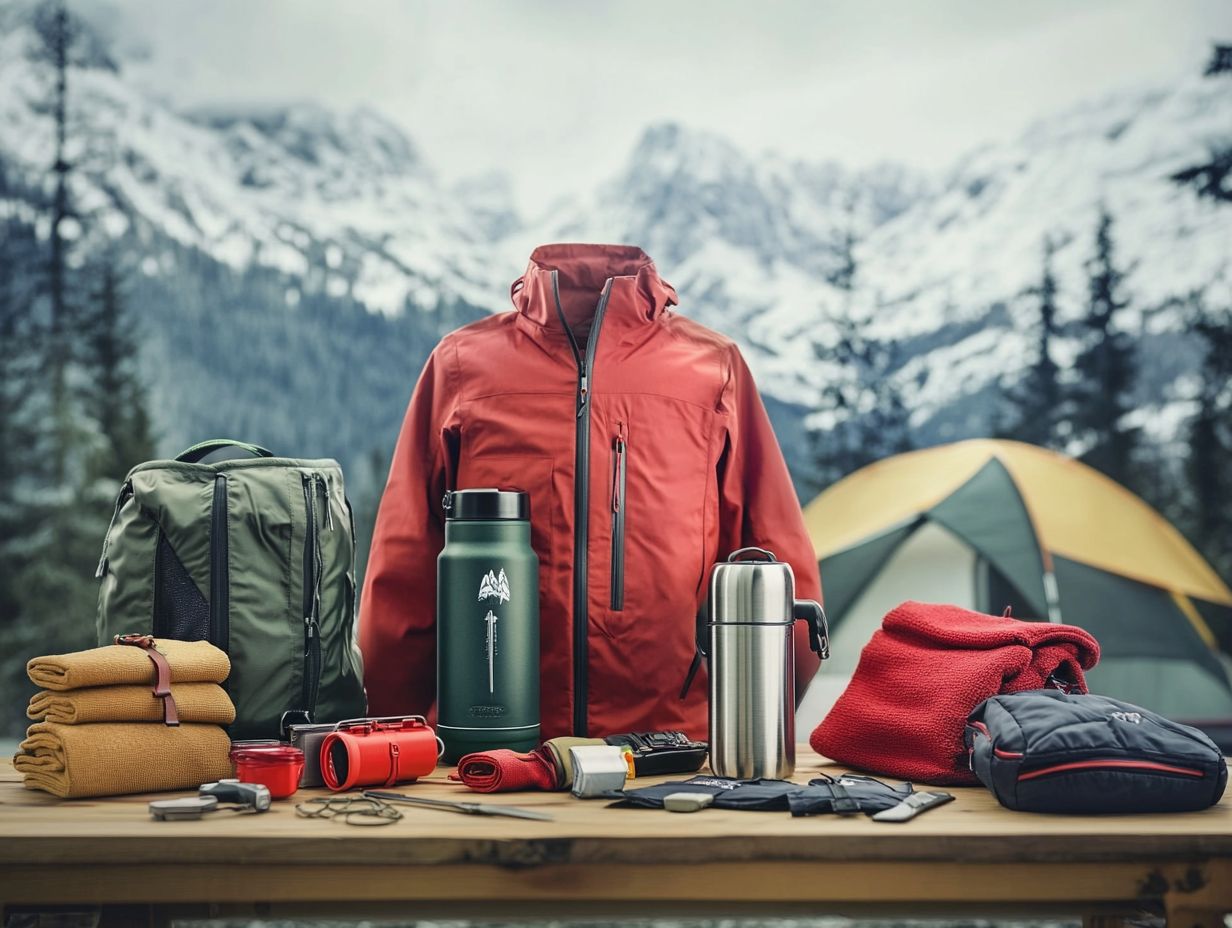
- Proper gear selection is crucial for survival in different climates.
- Insulation, shelter, and navigation are essential for cold climates, while hydration, sun protection, and first aid are important for hot climates.
- Consider personal needs and budget when choosing gear for different climates.
Understanding Climate-Specific Survival Gear
Understanding climate-specific survival gear is crucial for adventurers like yourself who seek to thrive in various environments, from the snow-capped peaks of Colorado to the humid trails of the Himalayas. Whether you’re embarking on a winter hiking expedition or navigating the Pacific Crest Trail, having the right equipment can make all the difference between a successful journey and a dangerous situation.
Essential items include:
- Cold weather gear featuring synthetic insulation (materials that trap heat while remaining lightweight) and waterproof outer layers, including options made with Gore-Tex.
- Navigation tools
- First aid kits tailored to your unique needs.
Consider factors like proper fit, comfort ratings, and local regulations to enhance your outdoor experience and ensure you re ready for whatever nature throws your way.
Importance of Proper Gear Selection
Proper gear selection is essential for outdoor enthusiasts, especially when you re facing extreme cold conditions. The right survival gear can make a world of difference in your safety and comfort.
In terms of choosing the right clothing, it s not just about looking good; it s about carefully assessing comfort ratings and fit. An optimal layering system is key, utilizing materials that wick moisture away while providing insulation to keep your body heat intact. Think insulated jackets, thermal socks, and waterproof footwear these are critical pieces that ensure you stay warm and dry.
As you delve into survival training, understanding how various fabrics perform in low temperatures can greatly influence your gear choices. Ultimately, being responsible in your gear selection not only elevates your outdoor experience but also enhances your preparedness, giving you the power to tackle the challenges of diverse climates with unwavering confidence.
Essential Gear for Cold Climates
When you re gearing up for a winter hiking adventure or planning to camp in frigid climates, investing in the right survival gear becomes crucial for your warmth and safety.
Your cold weather arsenal should feature high-quality insulation materials, including synthetic insulation and emergency thermal layers that excel in heat retention. Don t overlook waterproof outer layers they re essential for protecting against snow and moisture, elevating the overall effectiveness of your outdoor attire.
Moreover, specialized camping gear designed for extreme cold can greatly enhance your experience, allowing you to embrace the beauty of winter without compromise.
Don t wait gear up now and conquer the outdoors with confidence!
For effective survival in cold climates, it s essential for you to grasp the fundamentals of insulation, shelter, and navigation. These skills will elevate your outdoor experience.
Choosing the right insulation materials is crucial. They help retain body heat and prevent the chilling grip of the environment.
When you venture into frigid temperatures, selecting suitable shelters such as four-season tents, tarps, or sturdy cabins is paramount. These structures are critical for providing warmth and protection.
Equally vital are your navigation tools. By effectively using maps, compasses, and GPS devices, which are navigation tools that help you find your way, you can stay on course and minimize risks from harsh conditions.
Don t overlook the comfort ratings for your clothing and sleeping gear. They play a crucial role in helping you maintain an optimal body temperature.
For those traversing snow-covered landscapes, having the right survival gear like insulated boots and emergency supplies is critical for your safety and comfort during the journey. To ensure you’re well-prepared, consider learning how to choose the right survival gear for you.
Essential Gear for Hot Climates
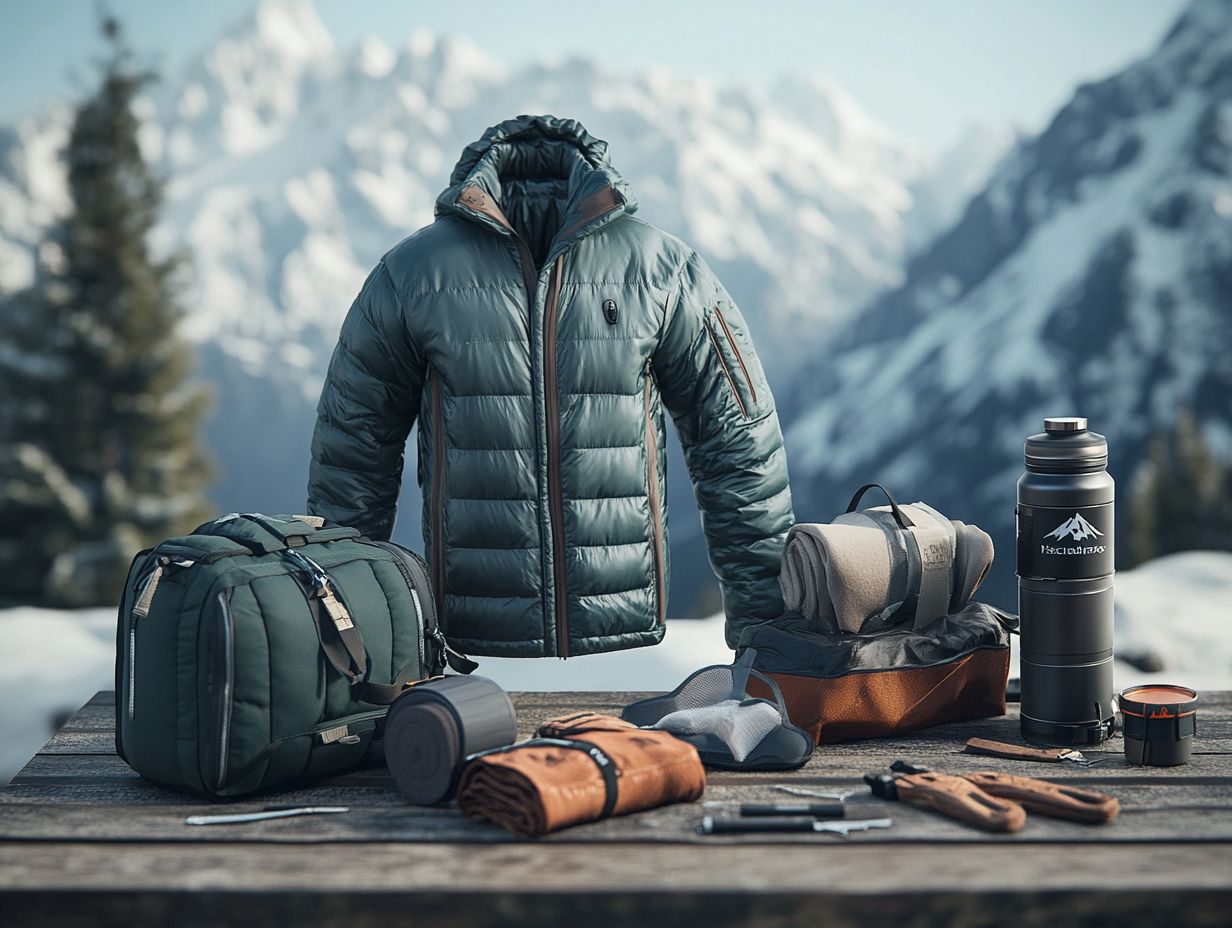
When you find yourself in hot climates, arming yourself with the appropriate survival gear is essential. This gear ensures you stay hydrated and provides vital sun protection, enhancing your overall safety during outdoor adventures.
Hydration, Sun Protection, and First Aid
Hydration, sun protection, and a well-stocked first aid kit are essential elements of your survival gear when venturing into hot climates.
As you navigate scorching conditions, prioritizing hydration is crucial. This means sipping water regularly while exploring various methods for carrying it. Consider using insulated bottles or hydration packs for easy access on the go.
In terms of sun protection, think beyond simply applying sunscreen. Choose the right clothing, like lightweight, long-sleeved shirts and wide-brimmed hats, which provide substantial shielding against harmful UV rays.
Equipping yourself with a comprehensive first aid kit guarantees your preparedness for unforeseen incidents. This proactive approach allows you to respond swiftly to issues like heat exhaustion or minor injuries, a critical advantage during your outdoor adventures.
Essential Gear for Wet Climates
In wet climates, possessing the right survival gear is crucial for staying dry and secure as you embark on a hiking adventure or camping trip. This thoughtful preparation ensures you can fully enjoy the beauty of nature without compromising your safety.
Waterproofing your gear, selecting the right shelter, and utilizing effective navigation tools are essential strategies for thriving in wet climates.
By treating your bags, tents, and clothing with high-quality waterproofing agents or opting for items designed with built-in moisture resistance, you can effectively protect your essentials from the relentless rain.
For shelter, consider options like tarp setups or waterproof tents that are specifically crafted for torrential downpours. These provide the protection and durability needed for a comfortable camping experience.
For navigation in challenging conditions, invest in reliable tools like waterproof maps and GPS devices that boast robust weather resistance. They significantly enhance your safety and efficiency.
Recognizing the importance of high-quality camping gear ensures you are well-prepared, empowering you to thrive in even the most unpredictable weather.
Essential Gear for Dry Climates
When navigating dry climates, it’s essential to prioritize the right survival gear. This helps maintain hydration, ensures sun protection, and upholds your overall safety in the great outdoors.
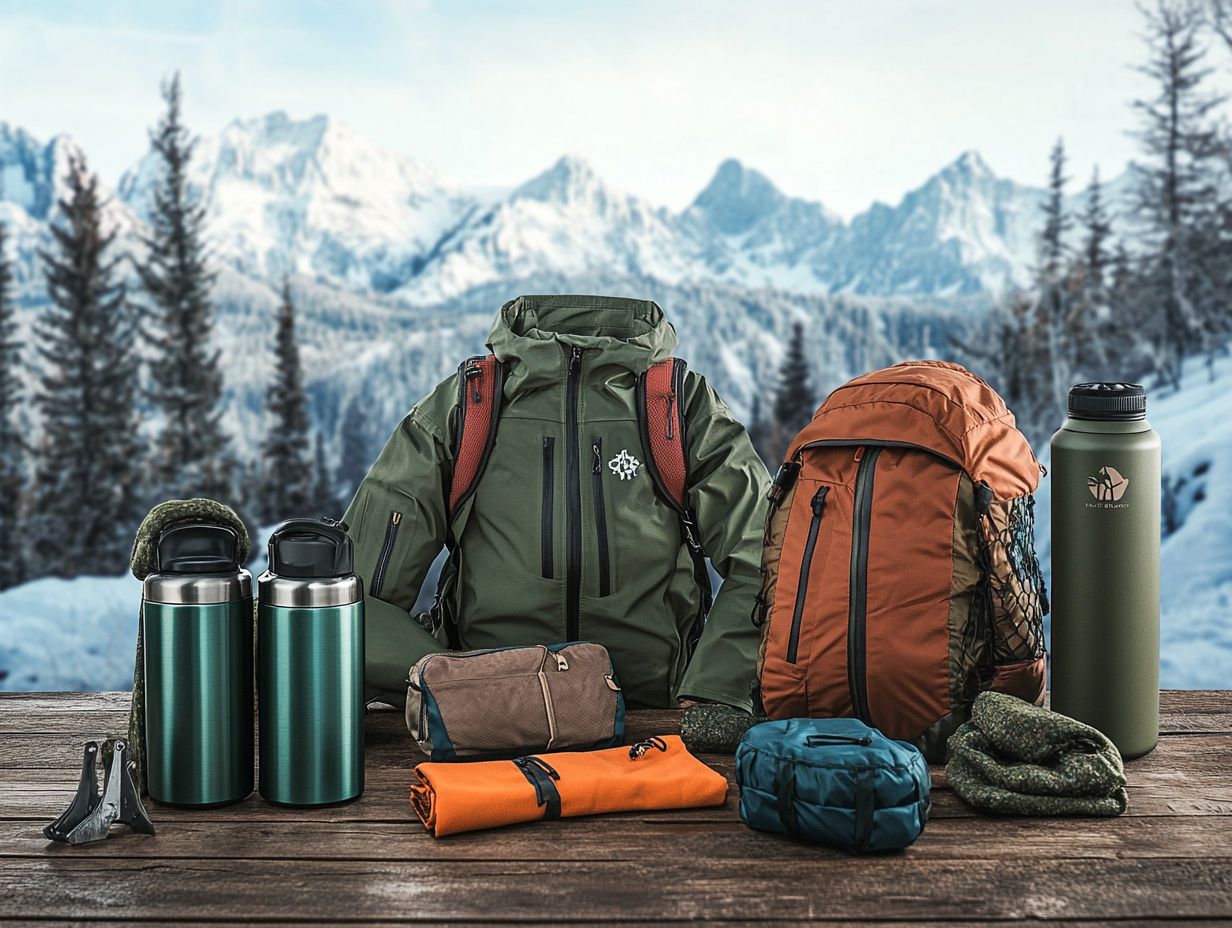
Ensuring you have a reliable water supply, effective sun protection, and navigational tools is essential when it comes to survival gear for dry climates. These critical components not only enhance your chances of survival but also significantly improve your comfort during extended stays in arid environments.
Efficient water storage methods, like portable filtration systems or solar stills, can help you maximize hydration in the desert. Pair that with lightweight, breathable clothing and UV-blocking gear to mitigate the risks of sun exposure.
High-quality maps and GPS devices designed for desert navigation are critical. They help you avoid hazards and locate essential resources.
It s crucial for anyone venturing into these challenging terrains to equip themselves with the right tools and strategies.
Factors to Consider When Choosing Gear
Choosing the right gear requires a good understanding of your personal needs, how much money you can spend, and the essential features that guarantee both comfort and efficiency in your survival equipment.
Personal Needs and Budget
Understanding your personal needs and establishing a budget are essential steps in selecting suitable survival gear for your outdoor adventures.
These factors can vary greatly depending on the activities you have in mind be it hiking, camping, or climbing. The climate is also a significant consideration. If you’re heading into cold, wet conditions, you ll need different equipment than if you’re exploring sunnier landscapes.
Don t underestimate the importance of personal preferences, such as comfort and style. The right gear can elevate your overall experience.
Strike a balance between cost and quality. Investing in durable outdoor clothing and gear with high comfort ratings often proves more advantageous than continuously replacing cheaper options.
Frequently Asked Questions
What factors should I consider when choosing survival gear for different climates?
When choosing survival gear for different climates, consider the temperature, terrain, and potential hazards specific to that climate. Also, think about how long you may need to survive and the availability of resources in that environment.
How do I determine the temperature rating for survival gear?
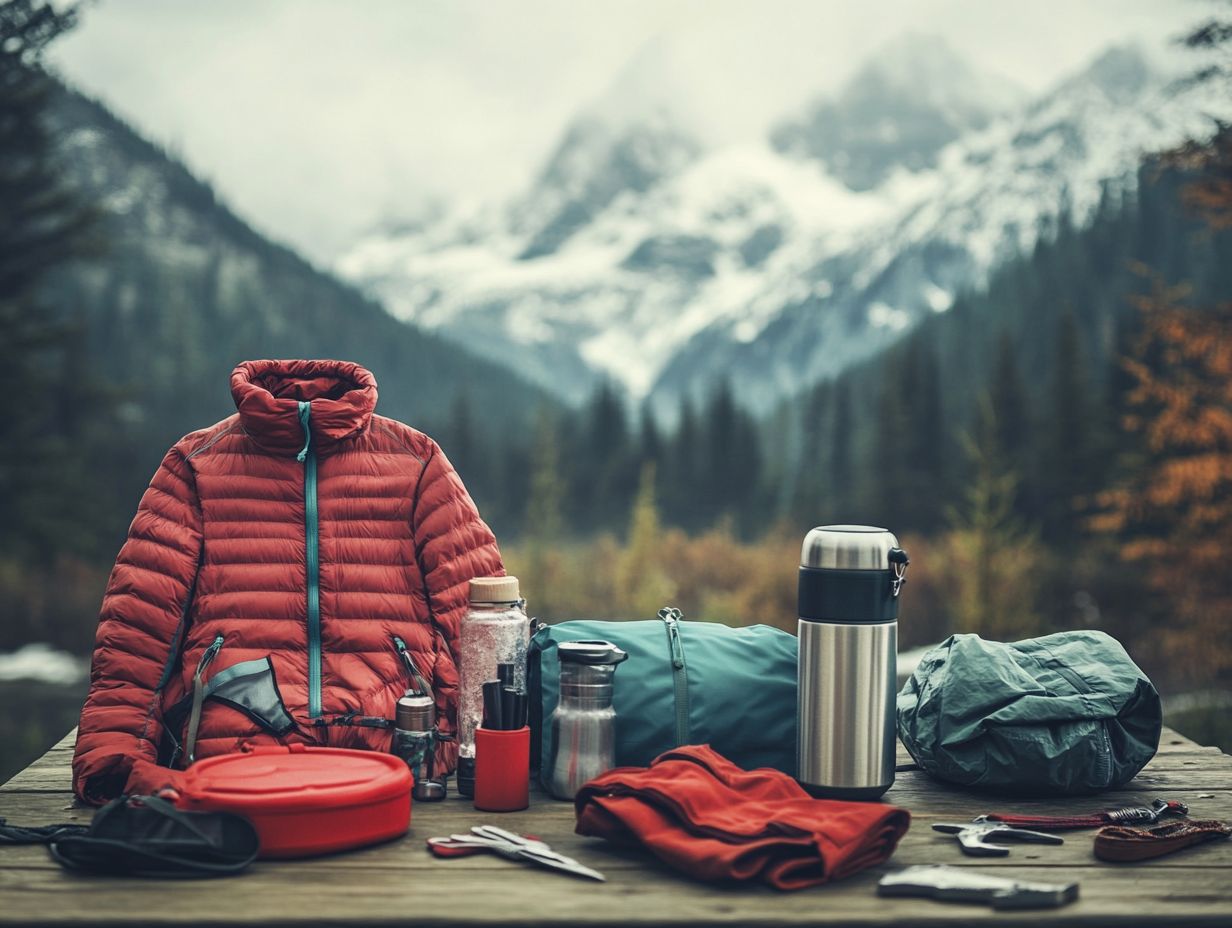
The temperature rating for survival gear is typically listed on the product label. This rating indicates the lowest temperature at which the gear will keep you warm.
Choose gear with a temperature rating that is lower than the lowest temperature you may encounter in your chosen climate.
What type of shelter should I pack for different climates?
The type of shelter you should pack will vary depending on the terrain and weather conditions. For cold climates, a tent or insulated shelter is recommended.
For hot and humid climates, a lightweight and breathable shelter, such as a tarp or hammock, may be more suitable.
How can I ensure my survival gear is waterproof?
To ensure your survival gear is waterproof, look for products made from waterproof materials, such as Gore-Tex or ripstop nylon. Consider using waterproofing sprays or sealants on your gear for extra protection.
What are some essential items to pack for survival in a desert climate?
Essential items for survival in a desert climate include a water filtration system, sunscreen, a wide-brimmed hat, and lightweight, breathable clothing.
Also, have a tarp or other shelter for protection from the sun.
Can I use the same survival gear for different climates?
While some survival gear may be versatile enough for use in different climates, choose gear specifically designed for the climate you will be in.
A heavy winter coat may not be suitable for a hot and humid climate, and a lightweight poncho may not provide enough warmth for a cold climate.

